Sometimes when a caller is asking about a return copy, they are alarmed. A filer may feel data is being dropped by the SEC or GoFiler. Put quite simply, the data supplied when retrieving return copy from the SEC is not simple HTML. However, most internet browsers will attempt to display the data and succeed to a degree, which causes confusion for filers. When the browser attempts to display the return copy, they assume that it is an exact copy of the submission. In fact, a return copy is not an exact copy and it is not meant to be one either.
A brief discussion of EDGAR will go a long way in helping understand the purpose of the return copy feature and what exactly a “return copy” is.
EDGAR filings are important. Some may be routine compliance such as a basic Section 16 transaction. Others could be critical like a pricing amendment that is filed as a company is getting ready to sell new securities. Early in the development of EDGAR (circa 1993), there was a basic fear that the data being filed would not be received and subsequently disseminated accurately. The system from 1933 to 1993 was paper. The EDGAR System was new; in fact, computers were still relatively new.
To ease the anxiety of filing electronically, the return copy function was added to EDGAR. This allowed filers to get a last look at the data they were transmitting and provided a level of comfort that the data was accurately received by EDGAR.
Over the last 20 years, the EDGAR System has been remarkably reliable. And while less relied upon, return copy is still used by some people as that last check before pulling the trigger and filing live. It also is still a great check to ensure that the data being received by EDGAR is accurate.
Quite recently, the rock solid nature of the EDGAR System was shaken during a system update where image data and image files were being corrupted after a filing was accepted and prior to posting return copy or being disseminated to the public. The bug was clearly illustrated using the return copy feature. The importance of return copy remains to this day.
When return copy was first developed, the EDGAR System only processed ASCII (typewriter style) filings. It was easy to open the return copy data in a text file to check everything. In later versions of the EDGAR System, the ability to submit complex data such as HTML, PDF, and images was added. A method of returning that data in a single file was still needed. The solution was to add simple dividers to the return copy data and encode binary information in a manner that allows it to be transmitted as text. Encoding is common practice for data transfer and is even used during the EDGAR submission processes. The only problem with encoding the return copy this way is that some of the data can look like it is HTML, but it is not. Further, while the return copy format relies on some standard practices, the overall format is not standard nor is it widely recognized.
“Return copy” is also a bit of a misnomer. The data is not actually returned to the filer but rather made available for download on the secure company side of the EDGAR website.
Understanding the Return Copy Format
Let’s take a look at a test filing. It has an HTML document and a single image and views in the browser as follows:
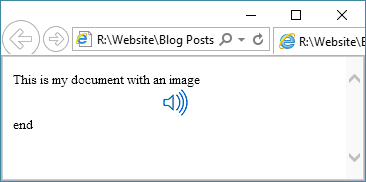
As mentioned above, return copy is a simple but non-standard format. As you can see, the format contains dividers marking each EDGAR document. These dividers are shown in blue:
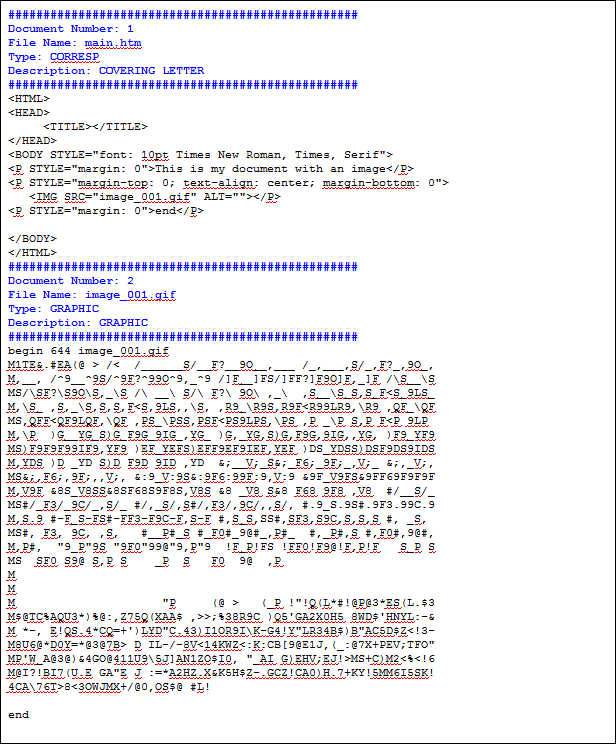
Note that the return copy format contains no additional information, no check codes, no EDGAR filing data. And if a submission is suspended or truncated, it will only contain part of the filed data.
For those of you who know HTML, it is clear that document “1” contains HTML code with an image reference. But where is the image? It is in document “2” as encoded data because its native format is binary. Those lines of random characters and text are the image; it’s simply been encoded so that the image file can be displayed inside of a text-only file.
The Common Mistake
It is easy to just drop the .rc file into a browser to view it. (You may have to change the file extension from .rc to .htm as shown in the address bar below.)
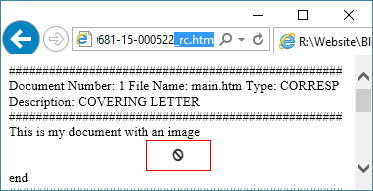
Notice the image (red highlighting added for illustrative purposes) does not appear and the divider information is added. To add to the confusion, a common practice of placing the downloaded return copy in the same folder as the original submission will cause the original image file to be available to the browser and subsequently appear as illustrated below:

The image links appear to work! But if you look at the rest of the return copy, the actual image data that was submitted is encoded and the browser has no idea was to do with it, so it just displays it as HTML text and relies on the unsubmitted copy of the image for display.

The fact that the image is displayed is serendipitous and often leads to common computing confusion: I believe my test worked but what is really happening is nothing like what I perceive is happening.
If the return copy is not placed in the same directory as the original submission (or is even placed in a folder that contains similarly named image files), the images will not display correctly. This lack of images and the additional divider data in the browser results in display errors and causes the panic some of our filers often feel when they attempt to open a return copy directly in a browser for review.
Without understanding exactly what the return copy is, filers assume that they have made an error or the EDGAR System has somehow corrupted their submission.
Using the Return Copy Correctly
The Return Copy file (.rc) must be unpacked or disassembled. Fortunately, all Novaworks EDGAR products have this feature built into them. After downloading the .rc file from the SEC, you can open the file directly in our software. The application will recognize the format and a dialog will be displayed:
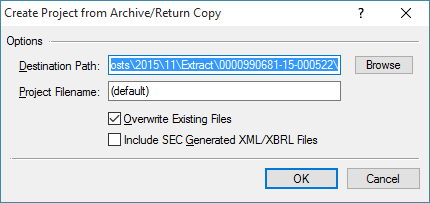
Just choose the location to “unpack” the return copy file. After the function runs, your destination folder will contain each document file. This is a little like unzipping or decompressing a folder.
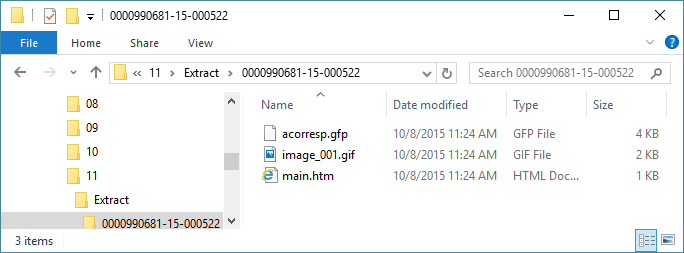
Additionally, GoFiler will create a new GoFiler project that contains the full submission. Then each HTML file can be properly viewed in a browser or proofed as the whole project. The only other way to process the data is to manually cut the .rc file apart and then decode the binary data with a utility.
Our software developers have written such a utility that you can download for free. This utility is written in the Legato Scripting Language, which is developed by Novaworks, but does not require any additional software to run. You can use the utility just by downloading it and running it from your computer. Once the utility is opened, just specify a return copy file that you have downloaded from the SEC, and the tool will extract the contents of the submission to the desired folder for your review.
How do I request a Return Copy?
If you have never used or heard of return copy, here’s a quick overview of how you can get one. In order to have return copy data available for download after filing, the submission must have the “return copy” option checked. In Gofiler, this option appears within the Submission Contact Information section of the project when it is opened in EDGAR Submission View:

In EDGARLink Online, you can select the option in the same area as the type of submission:
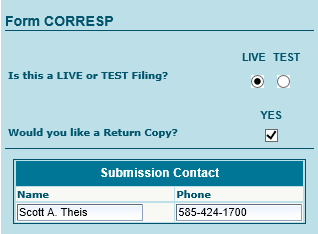
Note that return copy is not available on all form types.
After the filing has been accepted, you can retrieve the return copy from the EDGAR website. You’ll have to log into the EDGAR System and click the Retrieve/Edit Data link on the left navigation bar. Then select “return copy”:
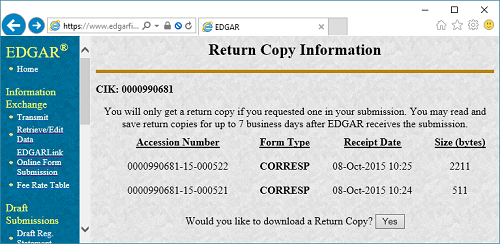
This screen shows all of the return copy data that is available on EDGAR for you to download. Each filing is listed with its accession number. Press the “Yes” button to choose to download a return copy. A screen will appear where you can select which filing to download:
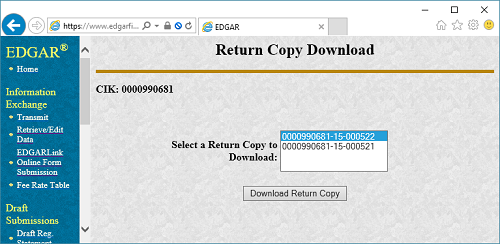
Choose the desired filing and press the Download Return Copy button. Another screen will appear with the link to download the return copy.
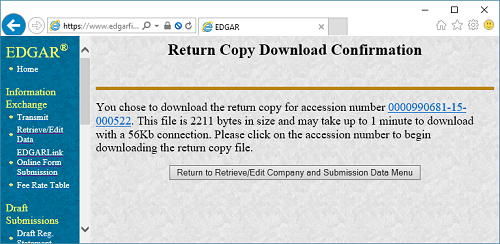
Click on the linked accession number to download the return copy file. That’s it!
Final Remarks
Return Copy has absolutely no legal or regulatory bearing on a submission. It is a way to confirm that what was submitted to the EDGAR System is true to the original converter or prepared EDGAR data. As a developer, we use Return Copy extensively as part of our Q/A process to make sure our software is correctly submitting data to the SEC 100% of the time. You can use it too as a final check that your filing is accurate now that you know what that
“return copy” file really is!

















